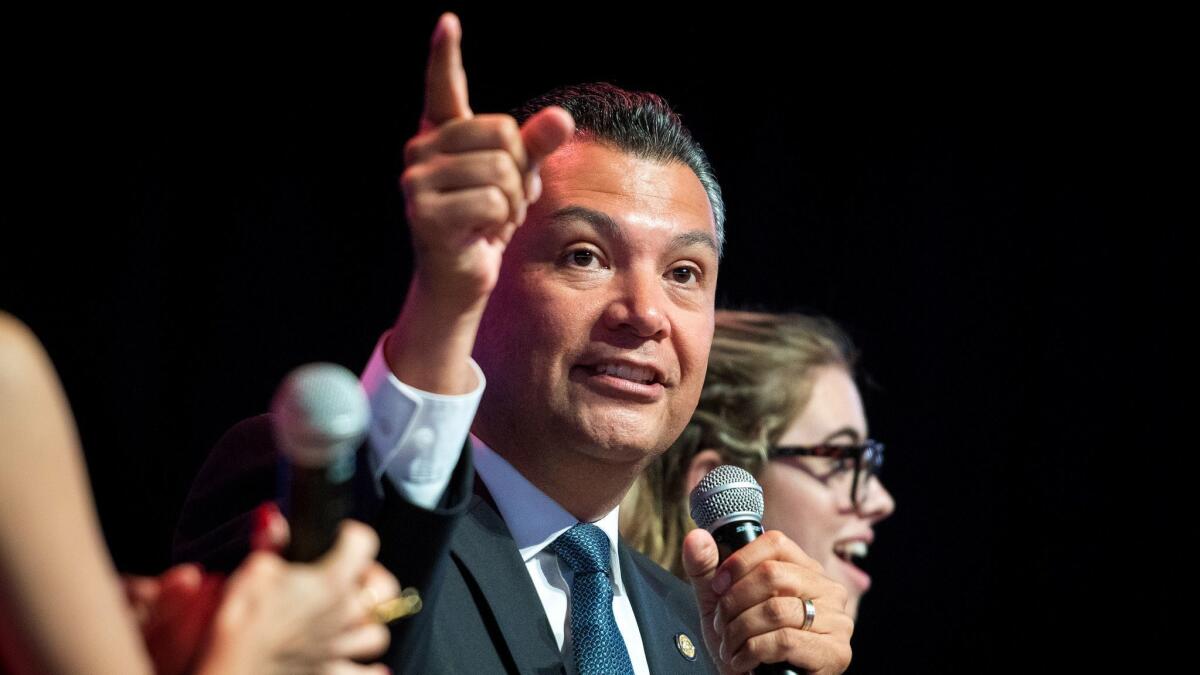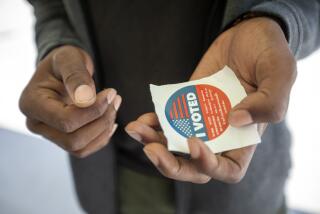Q&A: Alex Padilla talks California election security in Washington

- Share via
Reporting from Washington — When Alex Padilla was elected California’s secretary of state in 2014, his goal was to boost the state’s sagging voter turnout.
But Russian meddling in the 2016 presidential campaign changed the job, making cybersecurity a high priority for Padilla and his counterparts in other states.
He visited the Los Angeles Times bureau in Washington on Tuesday, a day before he was scheduled to testify to Congress about safeguarding elections.
Are you surprised how important election security has become?
It was a little bit on our mind. But it’s clearly become much more than even I anticipated. [In 2014,] 99% of the questions I was asked by voters would be, ‘What are you going to do to get more people registered to vote, and how can you increase turnout, participation in California?’
And then 2016 happens. From August 2016 to January 2017, when [then-Homeland Security] Secretary [Jeh] Johnson made the official critical infrastructure designation [which increased federal support for safeguarding election systems alongside dams, power plants and other significant facilities], it was a crash course.
Are elections more secure now than in 2016?
I like to think we’re at least a little better than we were in 2016, for no other reason than awareness is significantly elevated. Marginally, $380 million was appropriated by Congress last year for cybersecurity grants to states. California’s share was $34 million that we’ve been able to utilize.… We still need more and consistent investment in elections infrastructure and security.
What would you spend it on?
Upgrading or replacing systems. In California and throughout the country, the vast majority of what’s out there now was purchased with the last round of [Help America Vote Act] dollars. You’re talking about investments 15, 17 years ago, so you’re looking at 20-plus-year-old technology. You wouldn’t settle for that in your smartphone. But that’s what we have in the election world. ...
You cannot underestimate cyber training, training, training. You can have the best encryption, firewalls, all the tools you want. But if one member of our staff clicks on a link from a long-lost uncle who just won the lottery and wants to transfer money, it’s all compromised.
Is California getting what it needs from the federal government?
We definitely need more federal investment.… There’s a moment of awareness right now, and general public opinion, that this is critical. It is literally a matter of national security. For one-tenth of one percent of the last Defense appropriation, we could have done a lot of good in the area of election security. But the prior Congress saw otherwise.
California moved its presidential primary to March 3, 2020, three months earlier than in previous cycles, so the state can play a bigger role in picking nominees. What’s your view?
Look, I’m excited. Here’s the bottom line. We made it a lot easier if you’re eligible to be a registered voter in California. Our automatic registration has shown big success and big numbers. We’re making it easier for registered voters to cast their ballots with more counties now adopting the Voter’s Choice Act. More vote by mail, real in-person early voting, same-day registration, all of those tools.
And with California now early in the primary calendar, it’s forcing candidates … to come and earn votes in California. I’m excited about what that will mean for engagement and turnout.
California is notorious for counting ballots slowly. How long until we know who wins the primary?
It could take as long as 30 days. That’s what the canvass period is. But it will be up to voters to determine how close the election is going to be.
Why can’t you do it faster?
It’s not just a matter of what my office can do at the state level. But it’s much more about what counties would need to process those ballots more quickly. It comes back to the resource question. Not only are we working with some outdated technology ... [we need] better staffing at elections offices in counties up and down the state.
How much would it cost?
At least tens of millions if you’re looking at staffing and probably equipment too. The larger jurisdictions, like Los Angeles County, Orange, San Diego, Alameda, etc., are not counting the ballots by hand. There’s equipment being utilized. So how quick and reliable is that? And you don’t want to just take the machine’s word for it. We have postelection audits.
We’re never going to reduce the canvass period to two, three days. It will always take at least a few weeks because of the sheer volume of California. There’s a lot of ballots to be processed.
California recently legalized so-called ballot harvesting, which allows any person to collect a mail-in ballot from voters and submit the vote to a polling place or the registrar’s office. How did it go last November?
As far as I can tell, we’ve gotten no complaints from voters. And frankly, that’s the proper lens to look at this. The change in the law empowers voters to decide who they feel most comfortable with returning their ballots. For a lot of people it is maybe their husband, their wife, their son, their daughter. But I trust my neighbor. If I wasn’t going to the polls on election day, I’d trust my neighbor to turn it in. Why not?
More to Read
Get the L.A. Times Politics newsletter
Deeply reported insights into legislation, politics and policy from Sacramento, Washington and beyond. In your inbox three times per week.
You may occasionally receive promotional content from the Los Angeles Times.











